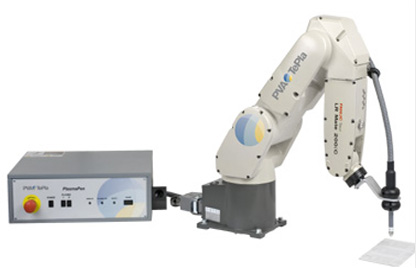
The Robo Pen System is an automated version of the patented atmospheric PlasmaPen™. The RoboPen™ is used to prepare surfaces by cleaning and activating materials such as polymers, glass, ceramics, metals, etc. for a broad range of applications spanning Life Science, Electronics and Industrial markets. Surface cleaning with the RoboPen™ ensures reliable wire and die bonding in semiconductor packaging, and has shown particular success in adhesion promotion of anisotropic conductive film (ACF) used in flat panel display manufacturing. The RoboPen™ increases the surface energy of materials promoting wettability of potting compounds, adhesives, inks, paints and dyes.
The Robo Pen is a self-contained, automated atmospheric plasma treatment system that can be configured and/or customized to meet a broad variety of manufacturing applications. PVA TePla works with a number of robot manufacturers in order to offer our customers a complete range of custom automation solutions. We provide any range of options starting with a basic table-top XYZ model up to the most complex multiple axis, vision recognition and high speed pick and place solution. Our product range allows customized programming and integration into any manufacturing line concept and we are able to partner with any customer preferred Robot Manufacturer.
Process gasses are flowed through the PlasmaPen™ assembly, activated and ejected through the nozzle. PVA TePla’s design allows compressed air (CDA) to be the standard treatment gas for most applications and provides for a very low cost of ownership. Other gasses can be utilized depending on the specific application.
Width of treatment band – 3 – 10 mm (configurable)
Service Interval – 1500 hours (gas dependent)
Standard Cable Length – 3 m – 6 m(9 – 18 ft.)
Power Requirements Electricity – 115 VAC, 1 phase, 60 Hz (4 amps max) 100 or 230 VAC, 1 phase, 50/60 Hz (4 amps max)
Compressed Air – Clean Dry Air (6 Bar, 88 psi), 1275 liters/hour (45cf3/h)
Other Gasses – N2, N2/H2, O2, CO2, He
Weight – 25 kg / 55 lbs
Adhesion Promotion of:
Independently laboratory tested: